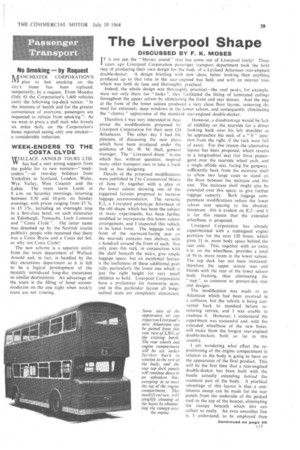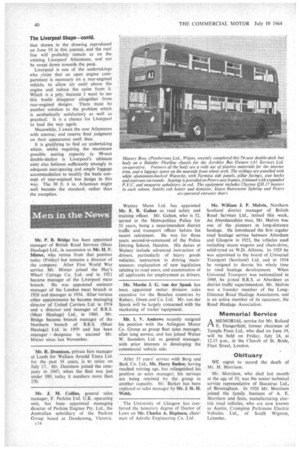The Liverpool Shape
Page 41

Page 42

If you've noticed an error in this article please click here to report it so we can fix it.
DISCUSSED BY F. K. MOSES
I T is not just the " Mersey sound" that has come out of Liverpool lately! Three years ago Liverpool Corporation passenger transport department took the bold step of producing their own design for the body of a Leyland Atlantean rear-engined double-decker. A design bristling with new ideas, better looking than anything produced up to that time in the rear-engined bus field, and with an interior trim which was both de luxe and thoroughly practical.
Indeed, the whole design was thoroughly practical—the roof peaks, for example, Were not only there for " looks ", they facilitated the fitting of, laminated ceilings throughout the upper saloon by eliminating the front and rear domes. And the step at the front of the lower saloon produced a very clean floor layout, removing the need for extremely deep windows in the lower saloon, and consequently eliminating the "clumsy" appearance of the standard rear-engined double-decker.
Therefore 1 was very interested to hear about the modifications proposed by Liverpool Corporation for their next 120 Atlanteans. The other day I had the pleasure of discussing the new plans which have been produced under the guidance of Mr. W. M. Hall, general manager. The "Liverpool shape" is one which has, without question, inspired many other transport men to take a fresh look at bus designing.
Details of the proposed modifications were published in The Commercial Motor of June 19, together with a plan of the lower saloon showing one of the suggested layouts proposed to increase luggage accommodation. The versatile E.2, a Liverpool prototype Atlantean of the old shape, which has been the subject of many experiments, has been further modified to incorporate this lower saloon arrangement, and I inspected this vehicle in its latest form. The luggage rack in Writ of the rearward-facing seat on the nearside contains two shelves, with a handrail around the front of each. Not only does this rack, in conjunction with the shelf beneath the stairs, give ample luggage space, but an incidental feature is the "usefulness of these additional grab rails, particularly the lower one which is just the right height for very small children to hold. LiverpoOl Corporation have a preference for transverse seats.• and in this particular layout all longitudinal seats are cOmpletely eliminated. However, a disadvantage would be lack of visibility on the nearside for a driver looking back over his left shoulder as he approaches the neck of a " Y " junction from the right, if the rack were full of cases. For this reason the alternative layout has been proposed, which reverts to a longitudinal seat (for three passengers) over the nearside wheel arch, and a single offside seat, facing the gangway. sufficiently back from the staircase shelf to allow two large cases to stand on the floor between the staircase and this seat. The staircase shelf might also be extended over this space, to give further luggage capacity. Both luggage compartment modifications reduce the lower saloon seat spacing to the absolute minimum this is evident on E.2—and it is for this reason that the extended wheelbase is proposed.
Liverpool Corporation has already experimented with a redesigned engine partition for the next 120 buses, which gives 3+ in. more body space behind the rear axle. This, together with an extra 6 in. on the wheelbase, provides a total of 91 in. more room in the lower saloon. The top deck has not been increased; therefore the upper saloon rear end blends with the rear of the lower saloon body framing, thus eliminating the step", so common on present-day rear end designs.
The modification was made to an Atlantean which had been involved in a collision, but the vehicle is being converted back to standard before reentering service, and I was unable to examine it. However, I understand the experiment was successful and, with the extended wheelbase of the new buses, will make them the longest rear-engined double-deckers built so far in this country.
I am wondering what effect the repositioning of the engine compartment in relation to the body is going to have on the appearance of the final product. This will be the first time that a rear-engined double-decker has been built with the bustle actually' extending behind the rearmost part of the body. A practical advantage of this layout is that a continuous sweep can be made for the rear panels from the underside of the peaked roof to the.top of the bonnet, eliminating the canopy beneath which dirt can collect so easily. An even smoother line is. I understand, to be employed than Continued on page 40 c 1 3
that shown in the drawing reproduced on June 19 in this journal, and the roof line will probably remain as on the existing Liverpool Atlanteans, and not be swept down towards the peak. Liverpool is one of the undertakings who claim that an open engine compartment is necessary on a, rear-engined vehicle, to allow air swirl above the engine and reduce the noise from it. Which is a pity, because I want to see this bustle disappear altogether from rear-engined designs. There must be another solution to the problem which is aesthetically satisfactory as well as practical. It is a chance for Liverpool to lead the way again.
Meanwhile, I await the new Atlanteans with • interest, and reserve final judgment on their appearance until then.
It is gratifying to find an undertaking which, whilst requiring the maximum possible seating capacity (a 90-seat double-decker is Liverpool's ultimate aim) also believes sufficiently strongly in adequate seat-spacing and ample luggage accommodation to modify the basic concept of rear-engined bus design in this way. The 30 ft. 6 in. Atlantean might well become the standard. rather than the exception.
























































































































